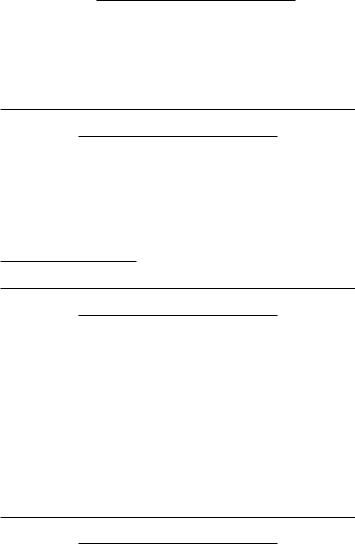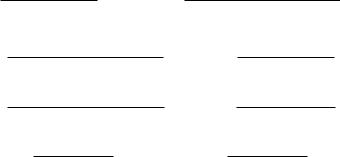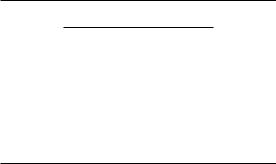
58 |
3/Propositional Logic |
of any algorithm for converting a proposition to disjunctive normal form?
(ii) Using the proof of theorem 3.3.1 and some of the identities of lemma 3.3.6, prove that every proposition A containing n propositional symbols is equivalent to a proposition A in disjunctive normal form, such that each disjunct Ci contains exactly n literals.
3.3.14. Let H be the truth function defined by the proposition
(P ¬Q) (¬P Q).
(i)Prove that (exclusive OR) is commutative and associative.
(ii)In this question, assume that the constant for false is denoted by 0 and that the constant for true is denoted by 1. Prove that the following are tautologies.
A B ≡ A B A B
¬A ≡ A 1
A 0 ≡ A
A A ≡ 0
A 1 ≡ A
A A ≡ A
A (B C) ≡ A B A C
A 0 ≡ 0
(iii) Prove that {, , 1} is functionally complete.
3.3.15. Using problems 3.3.13 and 3.3.14, prove that every proposition A is equivalent to a proposition A which is either of the form 0, 1, or
C1 ... Cn, where each Ci is either 1 or a conjunction of positive literals. Furthermore, show that A can be chosen so that the Ci are
distinct, and that the positive literals in each Ci are all distinct (such a proposition A is called a reduced exclusive-OR normal form).
3.3.16. (i) Prove that if A and A are reduced exclusive-OR normal forms of a same proposition A, then they are equal up to commutativity, that is:
Either |
A = A = 0, or A = A = 1, or |
A = C1 |
... Cn, A = C1 ... Cn , |
where each Ci is a permutation of some Cj (and conversely).
Hint: There are 22n truth functions of n arguments.
PROBLEMS |
59 |
(ii)Prove that a proposition is a tautology if and only if its reduced exclusive-OR normal form is 1. What does this say about the complexity of any algorithm for converting a proposition to reduced exclusive-OR normal form?
3.3.17. A set Γ of propositions is independent if, for every A Γ,
Γ− {A} |= A.
(a)Prove that every finite set Γ has a finite independent subset ∆ such that, for every A Γ, ∆ |= A.
(b)Let Γ be ordered as the sequence < A1, A2, .... >. Find a sequence Γ =< B1, B2, ... > equivalent to Γ (that is, for every i ≥ 1, Γ |= Bi
and Γ |
| |
|
i |
), such that, for every i |
≥ |
| |
i+1 |
|
i |
), but |
|
= |
A |
|
1, = (B |
|
|
B |
|||||
= (B |
|
B |
i+1 |
). Note that Γ may be finite. |
|
|
|
|
|
||
| |
i |
|
|
|
|
|
|
|
|
||
(c) Consider a countable sequence Γ as in (b). Define C1 = B1, and for every i ≥ 1, Cn+1 = (Bn Bn+1). Prove that ∆ =< C1, C2, ... > is equivalent to Γ and independent.
(d)Prove that every countable set Γ is equivalent to an independent
set.
(e)Show that ∆ need not be a subset of Γ.
Hint: Consider
{P0, P0 P1, P0 P1 P1, ...}.
3.3.18. See problem 3.3.13 for the definition of a literal . A proposition A is a basic Horn formula i it is a disjunction of literals, with at most one positive literal (literal of the form P ). A proposition is a Horn formula i it is a conjunction of basic Horn formulae.
(a) Show that every Horn formula A is equivalent to a conjunction of distinct formulae of the form,
Pi, or
¬P1 .... ¬Pn, (n ≥ 1), or ¬P1 .... ¬Pn Pn+1, (n ≥ 1),
where all the Pi are distinct. We say that A is reduced .
(b) Let A be a reduced Horn formula A = C1 C2 ... Cn, where the Ci are distinct and each Ci is reduced as in (a). Since is commutative and associative (see problem 3.3.1), we can view each conjunct Ci as a set.
60 |
3/Propositional Logic |
(i)Show that if no conjunct Ci is a positive literal, or every conjunct containing a negative literal also contains a positive literal, then A is satisfiable.
(ii)Assume that A contains some conjunct Ci having a single positive literal P , and some conjunct Cj distinct from Ci, such that Cj
contains ¬P . Let Di,j be obtained by deleting ¬P from Cj . Let A be the conjunction obtained from A by replacing Cj by the conjunct Di,j , provided that Di,j is not empty.
Show that A is satisfiable if and only if A is satisfiable and Di,j is not empty.
(iii) Using the above, prove that the satisfiability of a Horn formula A can be decided in time polynomial in the length of A.
Note: Linear-time algorithms are given in Dowling and Gallier, 1984.
3.4 Proof Theory of Propositional Logic: The Gentzen
System G
In this section, we present a proof system for propositional logic and prove some of its main properties: soundness and completeness.
3.4.1 Basic Idea: Searching for a Counter Example
As we have suggested in Section 3.3, another perhaps more e ective way of testing whether a proposition A is a tautology is to search for a valuation that falsifies A. In this section, we elaborate on this idea. As we progress according to this plan, we will be dealing with a tree whose nodes are labeled with pairs of finite lists of propositions. In our attempt to falsify A, the tree is constructed in such a way that we are trying to find a valuation that makes every proposition occurring in the first component of a pair labeling a node true, and all propositions occurring in the second component of that pair false. Hence, we are naturally led to deal with pairs of finite sequences of propositions called sequents. The idea of using sequents originates with Gentzen, although Gentzen’s motivations were quite di erent. A proof system using sequents is very natural because the rules reflect very clearly the semantics of the connectives. The idea of searching for a valuation falsifying the given proposition is simple, and the tree-building algorithm implementing this search is also simple. Let us first illustrate the falsification procedure by means of an example.
EXAMPLE 3.4.1
Let
A = (P Q) (¬Q ¬P ).

3.4 Proof Theory of Propositional Logic: The Gentzen System G |
61 |
Initially, we start with a one-node tree labeled with the pair
(<>, < (P Q) (¬Q ¬P ) >)
whose first component is the empty sequence and whose second component is the sequence containing the proposition A that we are attempting to falsify. In order to make A false, we must make P Q true and ¬Q ¬P false. Hence, we build the following tree:
(< P Q >, < ¬Q ¬P >)
(<>, < (P Q) (¬Q ¬P ) >)
Now, in order to make P Q true, we must either make P false or Q true. The tree must therefore split as shown:
(<>, < P, ¬Q ¬P >) |
(< Q >, < ¬Q ¬P >) |
(< P Q >, < ¬Q ¬P >)
(<>, < (P Q) (¬Q ¬P ) >)
We continue the same procedure with each leaf. Let us consider the leftmost leaf first. In order to make ¬Q ¬P false, we must make ¬Q true and ¬P false. We obtain the tree:
(< ¬Q >, < P, ¬P >)
(<>, < P, ¬Q ¬P >) |
(< Q >, < ¬Q ¬P >) |
(< P Q >, < ¬Q ¬P >)
(<>, < (P Q) (¬Q ¬P ) >)
But now, in order to falsify the leftmost leaf, we must make both P and ¬P false and ¬Q true. This is impossible. We say that this leaf of the tree is closed . We still have to continue the procedure with the rightmost leaf, since there may be a way of obtaining a falsifying valuation this way. To make ¬Q ¬P false, we must make ¬Q true and ¬P false, obtaining the tree:
(< ¬Q >, < P, ¬P >) |
|
(< Q, ¬Q >, < ¬P >) |
|
(<>, < P, ¬Q ¬P >) |
(< Q >, < ¬Q ¬P >) |
||
(< P Q >, < ¬Q ¬P >) (<>, < (P Q) (¬Q ¬P ) >)
62 |
3/Propositional Logic |
This time, we must try to make ¬P false and both Q and ¬Q false, which is impossible. Hence, this branch of the tree is also closed, and our attempt to falsify A has failed. However, this failure to falsify A is really a success, since, as we shall prove shortly, this demonstrates that A is valid!
Trees as above are called deduction trees. In order to describe precisely the algorithm we have used in our attempt to falsify the proposition A, we need to state clearly the rules that we have used in constructing the tree.
3.4.2 Sequents and the Gentzen System G
First, we define the notion of a sequent.
Definition 3.4.1 A sequent is a pair (Γ, ∆) of finite (possibly empty) sequences Γ =< A1, ..., Am >, ∆ =< B1, ..., Bn > of propositions.
Instead of using the notation (Γ, ∆), a sequent is usually denoted as Γ → ∆. For simplicity, a sequence < A1, ..., Am > is denoted as A1, ..., Am. If Γ is the empty sequence, the corresponding sequent is denoted as → ∆; if ∆ is empty, the sequent is denoted as Γ → . and if both Γ and ∆ are empty, we have the special sequent → (the inconsistent sequent). Γ is called the antecedent and ∆ the succedent.
The intuitive meaning of a sequent is that a valuation v makes a sequent
A1, ..., Am → B1, ..., Bn true i
v |= (A1 ... Am) (B1 ... Bn).
Equivalently, v makes the sequent false if v makes A1, ..., Am all true and B1, ..., Bn all false.
It should be noted that the semantics of sequents suggests that instead of using sequences, we could have used sets. We could indeed define sequents as pairs (Γ, ∆) of finite sets of propositions, and all the results in this section would hold. The results of Section 3.5 would also hold, but in order to present the generalization of the tree construction procedure, we would have to order the sets present in the sequents anyway. Rather than switching back and forth between sets and sequences, we think that it is preferable to stick to a single formalism. Using sets instead of sequences can be viewed as an optimization.
The rules operating on sequents fall naturally into two categories: those operating on a proposition occurring in the antecedent, and those on a proposition occurring in the succedent. Both kinds of rules break the proposition on which the rule operates into subpropositions that may also be moved from the antecedent to the succedent, or vice versa. Also, the application of a rule may cause a sequent to be split into two sequents. This causes branching in the trees. Before stating the rules, let us mention that it is traditional in logic to represent trees with their root at the bottom instead of the root at the

3.4 Proof Theory of Propositional Logic: The Gentzen System G |
63 |
top as it is customary in computer science. The main reason is that a tree obtained in failing to falsify a given proposition can be viewed as a formal proof of the proposition. The proposition at the root of the tree is the logical conclusion of a set of inferences, and it is more natural to draw a proof tree in such a way that each premise in a rule occurs above its conclusion. However, this may be a matter of taste (and perhaps, aesthetics).
In the rest of this section, it will be assumed that the set of connectives used is { , , , ¬}, and that (A ≡ B) is an abbreviation for (A B) (B A), and an abbreviation for (P ¬P ).
Definition 3.4.2 The Gentzen system G . The symbols Γ, ∆, Λ will be used to denote arbitrary sequences of propositions and A, B to denote propositions. The inference rules of the sequent calculus G are the following:
Γ, A, B, ∆ → Λ |
( |
|
: lef t) |
Γ → ∆, A, Λ |
Γ → ∆, B, Λ |
( |
|
: right) |
||||||||
Γ, A |
|
B, ∆ |
→ |
Λ |
|
|
Γ |
→ |
∆, A |
|
B, Λ |
|
|
|||
|
|
|
|
|
|
|
|
|||||||||
Γ, A, ∆ → Λ Γ, B, ∆ → Λ ( : lef t) Γ, A B, ∆ → Λ
Γ, ∆ → A, Λ B, Γ, ∆ → Λ ( : lef t) Γ, A B, ∆ → Λ
Γ, ∆ → A, Λ |
( |
¬ |
: lef t) |
||||
Γ, |
¬ |
A, ∆ |
→ |
Λ |
|
|
|
|
|
|
|
||||
|
|
Γ → ∆, A, B, Λ |
|
( |
|
: right) |
|||||||
|
|
Γ |
→ |
∆, A |
|
B, Λ |
|
|
|||||
|
|
|
|
|
|
||||||||
|
|
A, Γ → B, ∆, Λ |
( |
|
: right) |
||||||||
|
Γ |
→ |
∆, A |
|
B, Λ |
|
|
||||||
|
|
|
|
|
|
||||||||
A, Γ → ∆, Λ |
( : right) |
||||||||||||
Γ |
|
→ |
∆, |
¬ |
A, Λ |
¬ |
|
|
|
|
|||
|
|
|
|
|
|
|
|
||||||
The name of every rule is stated immediately to its right. Every rule consists of one or two upper sequents called premises and of a lower sequent called the conclusion. The above rules are called inference rules. For every rule, the proposition to which the rule is applied is called the principal formula, the propositions introduced in the premises are called the side formulae, and the other propositions that are copied unchanged are called the extra formulae.
Note that every inference rule can be represented as a tree with two nodes if the rule has a single premise, or three nodes if the rule has two premises. In both cases, the root of the tree is labeled with the conclusion of the rule and the leaves are labeled with the premises. If the rule has a single premise, it is a tree of the form
(1) S1
(e) S2

64 |
3/Propositional Logic |
where the premise labels the node with tree address 1, and the conclusion labels the node with tree address e. If it has two premises, it is a tree of the form
(1) S1 |
S2 (2) |
S3
(e)
where the first premise labels the node with tree address 1, the second premise labels the node with tree address 2, and the conclusion labels the node with tree address e.
EXAMPLE 3.4.2
Consider the following instance of the :left rule:
A, B → P, D Q, A, B → D
A, (P Q), B → D
In the above inference, (P Q) is the principal formula, P and Q are side formulae, and A, B, D are extra formulae.
A careful reader might have observed that the rules ( :left), ( :right), (¬:left), and (¬:right) have been designed in a special way. Notice that the side proposition added to the antecedent of an upper sequent is added at the front, and similarly for the side proposition added to the succedent of an upper sequent. We have done so to facilitate the generalization of the search procedure presented below to infinite sequents.
We will now prove that the above rules achieve the falsification procedure sketched in example 3.4.1.
3.4.3 Falsifiable and Valid Sequents
First, we extend the concepts of falsifiability and validity to sequents.
Definition 3.4.3 A sequent A1, ..., Am → B1, ..., Bn is falsifiable i there exists a valuation v such that
v |= (A1 ... Am) (¬B1 ... ¬Bn).
A sequent as above is valid i for every valuation v,
v |= (A1 ... Am) (B1 ... Bn).
This is also denoted by
|= A1, ..., Am → B1, ..., Bn.

3.4 Proof Theory of Propositional Logic: The Gentzen System G |
65 |
If m = 0, the sequent → B1, ..., Bn is falsifiable i the proposition (¬B1 ... ¬Bn) is satisfiable, valid i the proposition (B1 ... Bn) is valid. If n = 0, the sequent A1, ..., Am → is falsifiable i the proposition (A1 ... Am) is satisfiable, valid i the proposition (A1 ... Am) is not satisfiable. Note that a sequent Γ → ∆ is valid if and only if it is not falsifiable.
Lemma 3.4.1 For each of the rules given in definition 3.4.2, a valuation v falsifies the sequent occurring as the conclusion of the rule if and only if v falsifies at least one of the sequents occurring as premises. Equivalently, v makes the conclusion of a rule true if and only if v makes all premises of that rule true.
Proof : The proof consists in checking the truth tables of the logical connectives. We treat one case, leaving the others as an exercise. Consider the ( :left) rule:
Γ, ∆ → A, Λ B, Γ, ∆ → Λ
Γ, (A B), ∆ → Λ
For every valuation v, v falsifies the conclusion if and only if v satisfies all propositions in Γ and ∆, and satisfies (A B), and falsifies all propositions in Λ. From the truth table of (A B), v satisfies (A B) if either v falsifies A, or v satisfies B. Hence, v falsifies the conclusion if and only if, either
(1)v satisfies Γ and ∆, and falsifies A and Λ, or
(2)v satisfies B, Γ and ∆, and falsifies Λ. 

3.4.4Axioms, Deduction Trees, Proof Trees, Counter Example Trees
The central concept in any proof system is the notion of proof . First, we define the axioms of the system G .
Definition 3.4.4 An axiom is any sequent Γ → ∆ such that Γ and ∆ contain some common proposition.
Lemma 3.4.2 No axiom is falsifiable. Equivalently, every axiom is valid.
Proof : The lemma follows from the fact that in order to falsify an axiom, a valuation would have to make some proposition true on the left hand side, and that same proposition false on the right hand side, which is impossible.
Proof trees are given by the following inductive definition.

66 |
3/Propositional Logic |
Definition 3.4.5 |
The set of proof trees is the least set of trees containing all |
one-node trees labeled with an axiom, and closed under the rules of definition
3.4.2in the following sense:
(1)For any proof tree T1 whose root is labeled with a sequent Γ → ∆, for any instance of a one-premise inference rule with premise Γ → ∆ and conclusion Λ → Θ, the tree T whose root is labeled with Λ → Θ and whose
subtree T /1 is equal to T1 is a proof tree.
(2) For any two proof trees T1 and T2 whose roots are labeled with sequents Γ → ∆ and Γ → ∆ respectively, for every instance of a two-premise inference rule with premises Γ → ∆ and Γ → ∆ and conclusion Λ → Θ, the tree T whose root is labeled with Λ → Θ and whose subtrees T /1 and T /2 are equal to T1 and T2 respectively is a proof tree.
The set of deduction trees is defined inductively as the least set of trees containing all one-node trees (not necessarily labeled with an axiom), and closed under (1) and (2) as above.
A deduction tree such that some leaf is labeled with a sequent Γ → ∆ where Γ, ∆ consist of propositional letters and are disjoint is called a counterexample tree. The sequent labeling the root of a proof tree (deduction tree) is called the conclusion of the proof tree (deduction tree). A sequent is provable i there exists a proof tree of which it is the conclusion. If a sequent Γ → ∆ is provable, this is denoted by
Γ → ∆.
EXAMPLE 3.4.3
The deduction tree below is a proof tree.
|
P, ¬Q → P |
|
|
Q → Q, ¬P |
|
||
|
¬Q → ¬P, P |
|
|
¬Q, Q → ¬P |
|
||
→ P, (¬Q ¬P ) |
Q → (¬Q ¬P ) |
||||||
(P Q) → (¬Q ¬P )
→ (P Q) (¬Q ¬P )
The above tree is a proof tree obtained from the proof tree
|
P, ¬Q → P |
|
|
Q → Q, ¬P |
|
||
|
¬Q → ¬P, P |
|
|
¬Q, Q → ¬P |
|
||
→ P, (¬Q ¬P ) |
Q → (¬Q ¬P ) |
||||||
(P Q) → (¬Q ¬P )

3.4 Proof Theory of Propositional Logic: The Gentzen System G |
67 |
and the rule
(P Q) → (¬Q ¬P )
→ (P Q) (¬Q ¬P )
In contrast, the deduction tree below is a counter-example tree.
|
|
|
|
Q → P |
|
||
|
|
|
|
Q, ¬P → |
|
||
P → Q |
|
|
¬P → ¬Q |
|
|||
→ (P Q) |
→ (¬P ¬Q) |
||||||
→ (P Q) (¬P ¬Q)
The above tree is obtained from the two counter-example trees
|
|
|
|
Q → P |
|
||
|
|
|
|
Q, ¬P → |
|
||
P → Q |
|
|
¬P → ¬Q |
|
|||
→ (P Q) |
→ (¬P ¬Q) |
||||||
and the rule
→(P Q) → (¬P ¬Q)
→(P Q) (¬P ¬Q)
It is easily shown that a deduction tree T is a proof tree if and only if every leaf sequent of T is an axiom.
Since proof trees (and deduction trees) are defined inductively, the induction principle applies. As an application, we now show that every provable sequent is valid.
3.4.5 Soundness of the Gentzen System G
Lemma 3.4.3 Soundness of the system G . If a sequent Γ |
→ |
∆ is provable, |
|
||
then it is valid. |
|
|
Proof : We use the induction principle applied to proof trees. By lemma 3.4.2, every one-node proof tree (axiom) is valid. There are two cases in the induction step.
Case 1: The root of the proof tree T has a single descendant. In this case, T is obtained from some proof tree T1 and some instance of a rule
S1
S2
